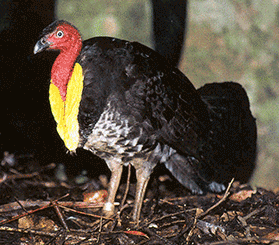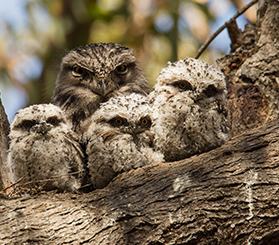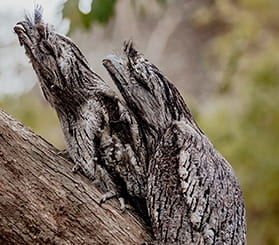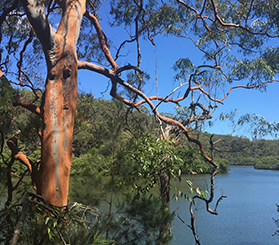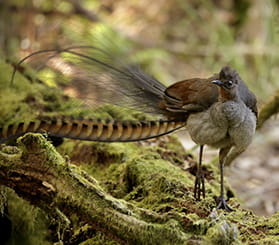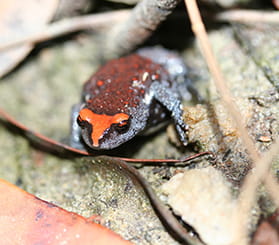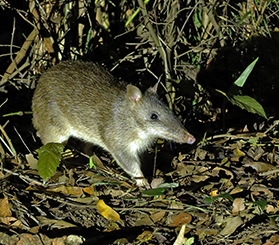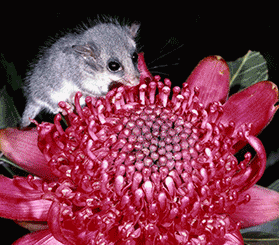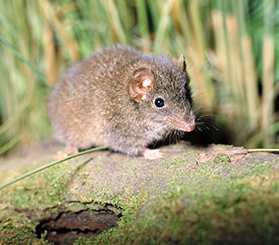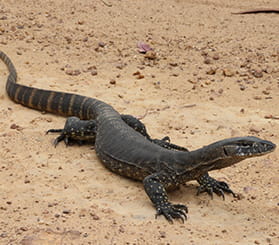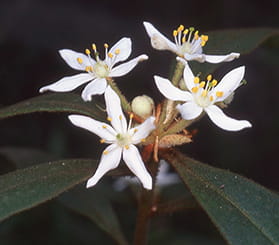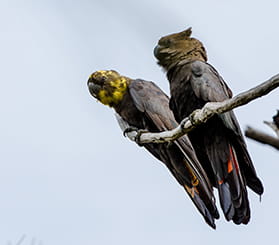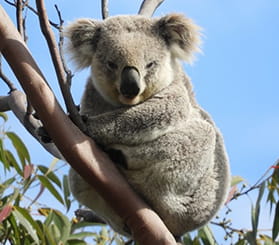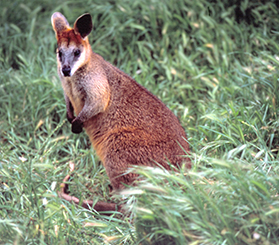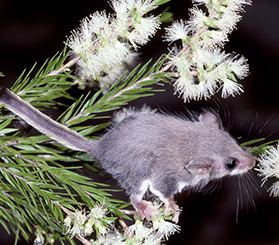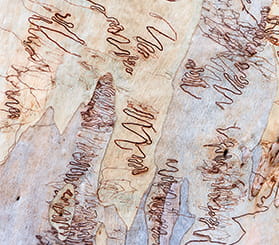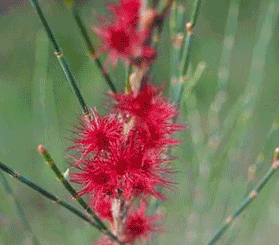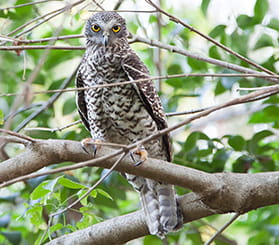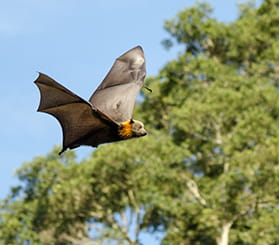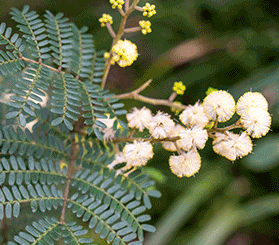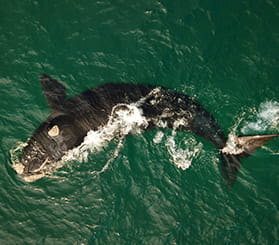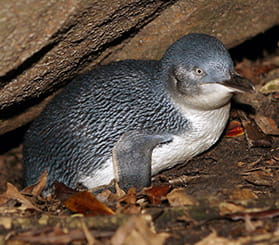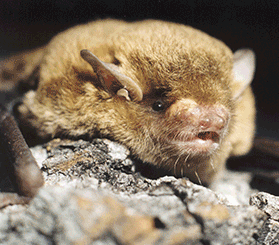Sydney's native habitats in 360
Explore our 360-degree interactive images to discover national park habitats in and around Sydney's urban fringe, and the protected plants and animals that take refuge here.
Read more about Sydney's native habitats in 360
Ku-ring gai Chase, Marramarra and Sydney Harbour national parks are special places, providing vital habitat for many threatened species. Areas in these parks have been declared Assets of Intergenerational Significance (AIS), to safeguard threatened animals and plants for future generations.
Bobbin Head, Ku-ring-gai Chase National Park
Discover the endangered and intriguing animals and plants hiding in plain sight in the Bobbin Head area of Ku-ring-gai Chase National Park.
Haloragodendron lucasii
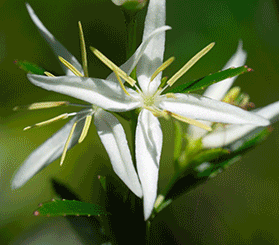
Endangered
Affectionately called ‘Hal’, this endangered plant has an amazing story similar to the Wollemi pine. It was first recorded in 1908, by Arthur Henry Lucas (hence lucasii), in northern Sydney. By 1926, further searches couldn't locate the species and it was presumed extinct. That is, until its rediscovery in 1986.
Some of the rediscovered plants were estimated to be 400 - 500 years old. Unusually, what looks like many plants is actually a single plant that clones itself, sending out a maze of underground runners that produce new growth. One plant can spread over 100m.
Today, ‘Hal’ exists only in the sandstone soils in and around Ku-ring-gai Chase National Park and Garigal National Park, where it's protected as an Asset of Intergenerational Significance. While creamy white flowers bloom in spring, studies have found most flowers are sterile with little or no pollen. With no observed seed, this endangered plant is still on the brink, relying instead on clonal reproduction. It also faces real risk from fire, human disturbance, weeds and pathogens.
You can see one of these protected plants at Kalkari Discovery Centre.
Photos: © Chantelle Doyle/UNSW; © Peter Taseski; © Ian Radosavljevic; © Matt Bollinger.
Peacock spider
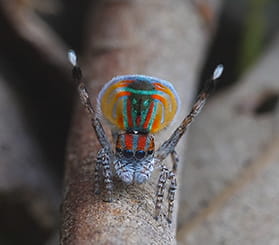
Protected
Native to Australia, this species of jumping spider was overlooked by science until one of them - the Maratus volans (pictured) - was caught on camera in Ku-ring-gai Chase National Park. Cue internet stardom and documentary fame.
Like peacocks, male peacock spiders have dazzling markings along with some cool moves to attract the ladies. A colourful flap on the male’s abdomen is covered in iridescent scales, making it look like a butterfly wing. During mating season, from September to November, they show off this flap while performing an amazing courtship dance that includes waving their legs, flapping and vibrating their abdomen, and energetically jiggling about. It’s a case of impress or risk being eaten by the female.
Despite their vibrant colours you’re not likely to see one. Afterall, these itsy bitsy spiders are about 4mm long – the size of a grain of rice. Watch a video of a male peacock spider courtship dance.
Photo and video: © iStock.com/crbellette.
Australian brush turkey
Protected
You might spot an adult brush turkey in the undergrowth. They’re easily recognised by their deep blue-black plumage, bald red head and yellow neck pouch (or wattle).
They’re common in coastal NSW, but during the Great Depression in the 1930s, brush turkeys were nearly wiped out when people used them for meat and eggs. Today, this native bird is protected under the Biodiversity Conservation Act 2016.
Between August and February, male birds rake up huge leafy mounds to entice females to lay up to 20 eggs deep inside the pile. Once hatched, chicks take 48 hours to dig themselves out and are left to fend for themselves. Unfortunately, they’re very vulnerable to attack by predators. On average, only one chick in every 200 eggs laid survives.
Photos: © Ann Goeth; Tegan Burton © DCCEEW; Johny Spencer © DCCEEW.
Tawny frogmouth
Protected
Tawny frogmouths live in this park, but you'll have a hard time trying to capture the 'Most Instagrammable' bird in the world on camera. These masters of disguise are so well camouflaged, quiet and still that they're often mistaken for tree branches.
These unique birds (they're not owls) pair for life and share parenting duties until young birds have fledged. Researchers have observed them grieving when their partner dies. Unfortunately many are hit by cars while chasing insects at night.
Tawny frogmouths have special adaptations to survive Australia's harsh environment. In cold winter months they can slow their heart rate and lower body temperature to save energy, while on hot summer days they produce a mucus that cools the air they breathe in.
While numbers are holding steady for now, the loss of old trees for nesting may affect tawny frogmouth populations in the future.
Photos: © Brayden Stanford; © Anna Maria Garcia.
Sydney red gum
Protected
Did you know, it was this species with its bright red sap (or gum) that inspired botanist Joseph Banks to call eucalypts 'gum trees'.
Also known as the smooth-barked apple or angophora, they're a familiar sight on sandy soils and sandstone ridges along the NSW east coast. The twisted trunks and branches shed bark during spring to reveal striking salmon-coloured bark, which fades to a pink-grey by winter.
Growing 15 to 30m high, they also offer important hidey holes and tasty summer flowers for nectar-loving animals like possums, bees, lorikeets and threatened species including flying-foxes.
Photo: © Natasha Webb.
Superb lyrebird
Protected
The superb lyrebird is famous for its amazing vocal range. They can mimic the calls, wing flaps and beak clicks of a huge range of local birds, as well as sounds made by mammals, including humans.
As they forage for insects and worms their powerful legs rake and shift tons of leaf litter, breaking up the dry leaves and twigs and pushing them into the soil. This speeds up decomposition and reduces fuel for ground fires.
You might see or hear them near Kalkari Discovery Centre, crossing Bobbin Head Road, or along Gibberagong track. Listen to a superb lyrebird's call and mimicry.
Photo: © Alissa Cook. Audio recording: © David Stewart Naturesound.
Orchids
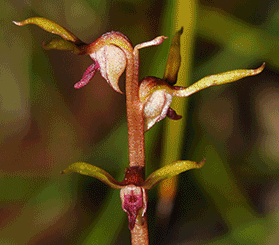
Protected
Orchids belong to the second-largest family of flowering plants in the world. These masters of adaptation are found in a huge range of habitats, in every continent except Antarctica. From ground-dwelling species to those hitching rides on trees or clinging to rocks, their ecological diversity is striking.
Ground-dwellers play seasonal hide-and-seek, only revealing their vibrant colours and shapes when in bloom. But these orchids are especially vulnerable to trampling, invasive weeds, and climate impacts. Several threatened species, like the Bauer's midge orchid, spider orchid, and mysterious eastern underground orchid, are protected in our Sydney national parks.
Photos: © Lachlan Copeland; © Peter Lockhart.
Red-crowned toadlet
Vulnerable
The red-crowned toadlet is a tiny frog that’s only found in a few places within the Sydney Basin. Unlike many other frogs that lay their eggs in water, this vulnerable toadlet lays their eggs on land.
They construct little nests beneath rocks and logs in amongst leaf litter, with the fathers standing guard as the eggs develop. Despite living on land, they still need water and rainfall to wash their partially developed tadpoles into creeks, where they’ll transform into toadlets.
Unfortunately, the red-crowned toadlet is under threat from urban development, habitat loss, and changes to the availability of water via dams, drainage and climate change. They have become locally extinct in at least 4 sites.
Photo: © Kelly Nowak.
Swamp oak floodplain forest
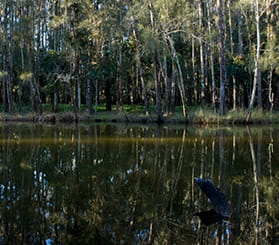
Threatened Ecological Community (TEC)
Kalkari lookout offers views over Cockle Creek. Here the mangroves meet swamp oak floodplain forest and coastal saltmarsh – both are Threatened Ecological Communities.
As the name suggests, swamp oak floodplain forest is usually dominated by swamp oak. Understorey plant species vary depending on how regularly and how long it’s waterlogged, and how salty the groundwater is. The influence of salt in soil and ground water set it apart from other floodplain communities.
Once widespread along the NSW coast from north to south, much swamp oak floodplain forest has been lost to clearing for urban or rural development, and to grazing by stock and feral animals. It’s also vulnerable to rising temperatures and long-term sea-level rise.
Photo: © Shane Ruming.
Zero extinctions
Did you know? NSW National Parks and Wildlife Service (NPWS) is the first national park agency in Australia to set a zero extinctions target for threatened species, and one of the first in the world.
Around 85% of the approximately 900 threatened species in NSW are found in our national parks and reserves. This highlights the critical role of national parks in the conservation of threatened species.
West Head, Ku-ring-gai Chase National Park
Uncover threatened and native species found in the coastal woodland, heath and scrub of the West Head area in Ku-ring-gai Chase National Park.
Long-nosed bandicoot
Protected
Once widespread across Sydney, the Northern Beaches area is one of the last strongholds of the long-nosed bandicoot in the region.
Known for their long snout, these champion diggers leave tell-tale round, cone-shaped holes from their night-time foraging in open grassy areas. This benefits the ecosystem by turning over and aerating the soil.
Bandicoots breed several times a year. Easy when you have the shortest gestation period of any marsupial – 11 to 13 days. When born, joeys are tiny and underdeveloped and travel through a cord connecting their mum’s womb to her pouch. Here, they drink milk and grow until they’re big enough to leave the pouch.
Photo: © iStock.com/Neil Bowman.
Eastern pygmy-possum
Vulnerable
Eastern pygmy-possums are essential pollinators for the bankisas, bottlebrushes and flowering eucalypts in this part of the park.
These adorable mini marsupials are one of the smallest possums in the world. Adults grow up to 10cm long and weigh around 43 grams – less than a golf ball! Listed as a vulnerable species in NSW, pygmy-possums from Ku-ring-gai Chase National Park have been successfully reintroduced to a wildlife sanctuary at North Head, where the species was locally-extinct.
Did you know? Pygmy-possums are the only marsupial that hibernates for long periods during winter. They curl up, fold in their ears and lower their body temperature and metabolic rate to conserve energy.
Photos: © iStock.com/Ken Griffiths; Ken Stepnell © DCCEEW; © Ian Bool; © Sue Brookhouse.
Brown antechinus
Protected
One of 13 species of antechinus (pronounced antic-eye-nis), this small, nocturnal, mouse-like marsupial uses tree hollows, crevices and logs in this park as their protective daytime dens.
Male antechinus live hard and fast. Mature by 11 months old, during mating season they have a rush of hormones and embark on a mating marathon to ensure breeding success. Exhausted, they die before their young are born. Talk about giving it their all.
Brown antechinus from the Ku-ring-gai population have been successfully translocated to a wildlife sanctuary at Sydney’s North Head, to help boost this harbourside population, where the species was locally-extinct.
Photo: Ken Stepnell © DCCEEW.
Southern brown bandicoot

Endangered
Ku-ring-gai Chase and Garigal national parks are home to 1 of the 2 stronghold populations of endangered southern brown bandicoot in NSW.
Shyer than the long-nosed bandicoot, they’re distinguished by their small round ears. They don’t stray far from their preferred shelter of dense heath vegetation, emerging at night to dig for insects, fungi, roots, larvae, earthworms and spiders - including the venomous funnel-web spider.
Seeing one is a rare experience. Sightings can be recorded via the Atlas of Living Australia citizen science app.
Photo: © Ricardo Simao.
Rosenberg's goanna
Vulnerable
Rosenberg’s goannas are found in heath and open forest in this area. Often mistaken for the larger, more common lace monitor, this threatened species can grow up to 1.5m long, and is recognised by its narrow, regular bands extending the length of its tail.
These carnivorous reptiles evolved from goanna ancestors 90 million years ago. Arriving in Australia about 15 million years ago, they evolved into around 28 species. One of these, the now-extinct Varanus priscus, grew over 6m!
During breeding, females dig a hole in the side of a termite hill to lay their eggs. The termites rebuild the mound over the 6-14 eggs, keeping them safe and at a steady 30 degrees Celsius. When the young hatch, some 8-9 months later, their mum returns to dig them out.
Unfortunately, this lizard is under threat from habitat loss and removal of habitat, including termite mounds and fallen timber shelter, dangers from vehicles, and predation from cats and dogs.
Please don't feed goannas if you encounter them in the park.
Photo: © Gavin Phillips.
Red bellied black snake
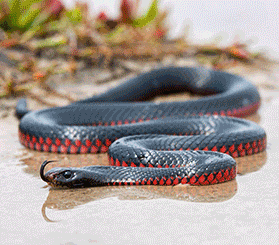
Protected
Like many Aussies, these snakes love sunshine and water. Despite their fearsome looks, there's never been a confirmed death from these shy snakes.
One of the most commonly-encountered snakes on the east coast, they’re especially active in spring, during breeding season. Males travel widely in search of a mate. If they cross paths with a rival male the fight is on. Both snakes rear up, hooking necks and intertwining their bodies in an attempt to push and hold their opponent down. They may hiss and bite each other. It’s an amazing sight.
Unusually, while most snake species lay eggs, female red bellied black snakes give birth to live young.
Photos: © iStock.com/Ken Griffiths; © Dirk Kotze/Shutterstock.com; © Doug Hewitt.
Grass tree
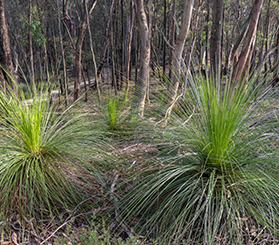
Protected
There are 66 species of grass tree, all of them found only in Australia. Depending on the species, these perennial flowering plants can grow 1-6m tall. These slow growing, long-lived plants are like old growth forest – some are hundreds of years old.
Old leaves hang down to form a ‘skirt’ around the base of the trunk, which offers shelter to small animals like bandicoots. The longer the skirt, the longer it’s been since the last fire.
Grass trees are well-adapted to fire, in fact their ability to resprout and flower after a bushfire makes them a lifeline for birds, insects and mammals that feast on the nectar, pollen and seeds.
Photo: Johny Spencer © DCCEEW.
A biodiversity hotspot
Considering its location on Sydney’s doorstep, it might come as a surprise to learn that Ku-ring-gai Chase National Park is a biodiversity hotspot. It’s rich in both land-based and aquatic species, with an outstanding concentration of endemic plants and native animals, especially birds.
The park includes complex plant communities including heathland, woodland, open forest, swamps and temperate rainforest. It’s home to over 1,000 native plant species, and provides critical habitat for many threatened animals..
Did you know? Ku-ring-gai Chase National Park is the second oldest national park in Australia, and the oldest national park established primarily for nature conservation. .
Marramarra National Park
Learn more about the precious plants and animals that make the Hawkesbury escarpment, eucalypt forest, and waterways of Marramarra National Park their home.
Asterolasia elegans
Endangered
This endangered native shrub is known from only 7 populations in a small area of northern Sydney around the Hawkesbury River valleys and rocky outcrops. It’s one of several hard-to-pronounce threatened plant species that are protected in Marramarra National Park. Zieria involucrata and Micromyrtus blakelyi also occur here.
Asterolasia elegans is a fire sensitive species. It's an obligate seeder, meaning it can only regenerate by seed after disturbance, like fire, rather than resprouting. Mature plants are killed by fire. Seeds might remain in the soil seedbank for 5-10 years - it's believed smoke and heat intensity during fires may influence seed dormancy and germination. With more intense and more frequent wildfire this species is at risk of disappearing.
Asterolasia elegans has been declared an Asset of Intergenerational Significance, giving it extra legal protections to safeguard its future.
Photo: © Barry Collier.
Glossy black-cockatoo
Endangered
‘Glossies’ are the smallest of the black-cockatoos. Despite the name, these birds are a dull brown-black with a red (males) or yellow-orange (females) tail panel.
These fussy eaters feed almost exclusively on seeds from the cones of she-oak trees (Allocasuarina and Casuarina). But these trees can take over 10 years to produce cones and grow branches thick enough to support a hungry glossy. Loss of these trees to fire and felling can devastate this endangered species’ food supply.
you’re lucky, you might hear them snacking. Listen for the tell-tale sounds of soft cracking cones, clicking of bills, and falling debris. Watch our glossy black-cockatoo video.
Photo: John Spencer © DCCEEW. Video: Alex Pike © DCCEEW.
Koala
Endangered
This park is home to important koala habitat. These iconic Aussie animals were once killed in their millions for their fur. By the early 1900s, they’d been hunted almost to extinction in some states. It was an unlikely hero who came to their rescue: US President Herbert Hoover. Hoover, who’d previously worked and travelled throughout Australia, was contacted by Australian conservationists and agreed to ban the import of both koala and wombat skins, effectively stopping the fur trade.
Today, this furry favourite still faces an uncertain future, with threats from widespread habitat loss, droughts, fires and stresses from encroaching busy roads and encounters with dogs.
Photo: © Steve Anyon-Smith.
Swamp wallaby
Protected
With their dark fur, rust-coloured patches and distinctive cheek stripe, ‘swampies’ are so different to other wallabies that they have their own genus - Wallabia.
‘They feed on shrubs, grasses and ferns, and can eat plants like bracken and hemlock which are poisonous to other native animals. While many mummy marsupials can suckle two joeys that are different ages, swamp wallabies can actually overlap pregnancies, gestating both an embryo and a foetus at the same time.
Add to that the ability to move each ear separately up to 180 degrees, a flexible tail that allows them to jump as high as 3m, and being great swimmers, you have one amazing Aussie animal.
Common in Sydney, you might spot swamp wallabies in bushland and picnic areas, usually in the early morning and late afternoon.
Photo: Ken Stepnell © DCCEEW.
Feathertail glider
Protected
The smallest gliding mammal in the world, the feathertail glider makes its home in woodland like this along Australia’s east coast.
Weighing an average of just 12g, and growing up to 8cm, these petite possums have a feather-like tail, fringed with stiff hairs, which acts like an in-flight rudder. Their gliding membrane extends from elbow to knee, allowing them to glide more than 20m between trees as they seek out pollen, nectar and insects.
Photo: © iStock.com/Ken Griffiths.
Coastal saltmarsh
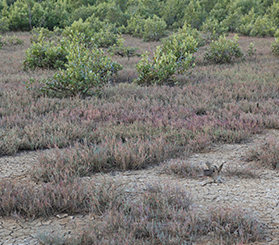
Endangered
Coastal saltmarsh in NSW is often found just inland from mangrove forests. You'll find this environment along the Hawkesbury River at Gentlemans Halt, Singletons Mill and Marramarra Creek.
These marshes are home to variety of animals including crabs, molluscs, insects, spiders, and many fish species, that use them as habitat during high tides. Some saltmarshes are crucial resting spots for migratory birds.
Coastal saltmarshes are under threat globally. Factors like infilling, invasive plants, damage from animals and human activity, changing water levels and salinity, and climate change endanger their existence. Pollution such as agricultural runoff and oil spills are also a threat. Without intervention, coastal saltmarshes in NSW could disappear entirely.
Photo: © Rosie Nicolai.
Hawkesbury sandstone
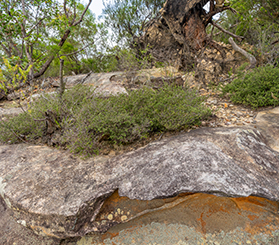
Hawkesbury sandstone, also known as Sydney sandstone, is the bedrock for much of the Sydney region. This sedimentary rock is made up of quartz sand with some shale mixed in. It forms solid blocks or layered sheets with distinct vertical cracks. This type of sandstone is also found on Mars.
A diverse range of native Australian plants have evolved and adapted to the shallow, nutrient-poor soils of this sandstone environment. Eucalypt trees thrive here. These trees protect their leaves by producing toxins that make them inedible to most animals (though not koalas). These chemicals also give the trees their characteristic smell.
Photo: John Spencer © DCCEEW.
Tree hollows
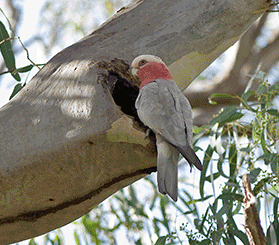
Natural tree hollows in both living and dead trees are essential for many threatened species as safe places to roost, breed and shelter from weather and predators.
Only old trees have hollows, created over time by wind, heat, fire, lightning, rain and attack from termites and beetles, or fungi and bacteria. Trees used as nest sites by glossy black-cockatoos and powerful owls can be many hundreds of years old.
Like buying a house, there’s a lot to consider when it comes to a suitable tree hollow, including entrance size and shape, depth, insulation, tree position and being close to food sources. The brown antechinus and sugar glider opt for hollows with very narrow entrances that predators can’t squeeze through, to protect their young.
Even dead trees, fallen branches and stumps provide important hollows and crevices used by wildlife like snakes, skinks, and frogs.
Photo: © John Turbill; © Rosie Nicolai; Johny Spencer © DCCEEW.
Scribbly gum
Protected
The scribbly gum is a common sight in Sydney’s national parks. These eucalypt trees are easily identified by the distinctive ‘scribble’ markings on their smooth trunks, made by moth larvae that leave trails as they tunnel between old and new bark.
Adult moths lay eggs in the tree’s bark in autumn. Soon after, larvae hatch and chomp on the tree bark while they wait out the winter. When the gum sheds its old bark, the trails are revealed.
The scribbly gum generally grows to 15m and produces white flowers in summer, attracting native Australian birds such as honeyeaters.
Photo: Michael Van Ewijk © DCCEEW.
Waratah
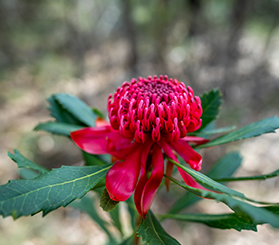
Protected
The iconic crimson flower of the waratah can be seen in spring on sandstone ridges around Sydney.
One of 5 waratah species, the NSW waratah is one of the most recognisable. This hardy flowering shrub grows up to 4m high and its flowerhead and bracts can be up to 15cm across.
It’s the emblem of NSW and one of Australia’s best-known native flowers. In fact, the waratah narrowly lost out to the golden wattle in the battle to become Australia’s national floral emblem, a debate that started in the early 1900s and ended in 1988. It’s believed the waratah lost because it only occurs on the east coast of Australia, while wattle is found across the country. Fair enough.
Photo: John Spencer © DCCEEW.
Nielsen Park, Sydney Harbour National Park
The popular Nielsen Park area of Sydney Harbour National Park is an urban refuge for native species, including several threatened plants and animals.
Nielsen Park she-oak
Endangered
The shallow sandy soils and sandstone shelves around Nielsen Park are the original habitat of the extremely rare Nielsen Park she-oak. This small, endangered shrub only survives today thanks to ongoing conservation efforts.
In the 1980s just 10 of these native plants were left in the wild. While the last of these died in the early 2000s, cuttings had been taken and led to successful propagation. New plants have been planted at Nielsen Park and in the local area.
No new seedlings have established from the plants - it’s thought that fire is needed to trigger germination. Before European settlement, fires would have occasionally burnt the landscape, allowing Nielsen Park she-oaks to regenerate. The only alternative to fire in this urban environment is continuous replanting.
To safeguard this species for future generations it's been declared an Asset of Intergenerational Significance.
Photos: © Bronwyn Kershaw; Alan Fairley © DCCEEW; Michael Van Ewijk © DCCEEW; Erica Mahon © DCCEEW.
She-oak trees and seeds
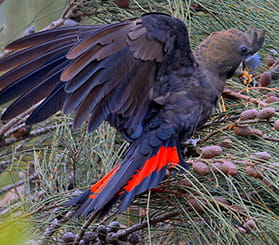
Protected
She-oak (Allocasuarina and Casuarina) trees, like the Nielsen Park she-oak, are dioecious, which means male and female flowers are on different trees. Only female trees produce the seeds that are a preferred food for the threatened glossy black-cockatoo.
But these slow-growing trees can take 10 years or more to produce their tasty seeds and develop branches strong enough to support hungry cockatoos.
Loss of these trees to fire, disease, land clearing and urbanisation can wipe out important food supplies for these endangered birds. So, the survival of our gorgeous ‘glossies’ is linked to the future of these trees. Watch our video of glossy black-cockatoos feeding.
Photo: © Charles Dove. Video: Alex Pike © DCCEEW.
Powerful owl
Vulnerable
The powerful owl is the largest nocturnal bird in Australia. It’s a typical hawk-owl, with large yellow eyes and black beak, but without the round facial-disc of barn-owls. Special fringed wing feathers help them fly and swoop on prey silently.
Possums - their favourite food – are increasingly found in built-up areas, so it’s no surprise powerful owls are also being spotted in the suburbs. They might be seen roosting by day in the dense shade of a tree, often holding the previous night’s catch in their frighteningly sharp talons.
This vulnerable species mates for life. Couples often call to each other with a double hoot before they head off hunting for the night.
Photo: © Rosie Nicolai.
Grey-headed flying-fox
Vulnerable
Grey-headed flying-foxes are unsung heroes when it comes to pollinating many of our native plants. Because they travel so far, they can carry pollen over greater distances than birds or bees. They also disperse seeds further than other animals. This makes them vital to the regeneration, genetic diversity and survival of our native forests along the east coast, especially after bushfires.
Australia's largest native bat, and the only true flying mammal (gliders glide rather than fly), the grey-headed flying-fox is protected as a threatened species. Land clearing, urbanisation and extreme climate events all contribute to natural habitat loss.
Photo: © Shane Ruming.
Eastern Sydney sunshine wattle
Endangered
While the golden wattle nabs top spot as Australia’s national floral emblem (it grows across the country), there’s a rare subspecies of wattle that’s exclusive to Sydney.
Eastern Sydney sunshine wattle is restricted to a small coastal area from Cronulla to Manly, and inland only as far as North Sydney. It occurs naturally in Sydney Harbour National Park, including at Nielsen Park.
Urban development, feral rabbits, and human disturbance have added to dwindling populations of this endangered species. But a successful partnership between the Saving our Species program and local primary school students has seen new plants propagated and planted at Middle Head and along bush tracks and re-vegetated areas at Headland Park, Mosman.
Photos: Johny Spencer © DCCEEW.
Southern Right whale
Endangered
In winter, southern right whales can be seen on the NSW coastline, and even in the waters and shallow bays of Sydney Harbour.
Named because they were the ‘right’ whale to catch during commercial whaling days (they were slow, floated when dead, and had lots of oil), around 75% of the population was taken between 1835 and 1845. It was another 90 years before they were officially protected.
Today numbers are recovering. If you’re lucky, you might see their crowd-pleasing antics like breaching and headstands. The species’ 2 separate blow holes produce a distinctive V-shaped blow.
Photo: © Lachlan Hall.
Little penguins
Endangered population
The only little penguin breeding colony on the NSW mainland is found across the harbour from Niselsen Park, at Manly and North Head. The smallest of all penguin species, little penguins mainly breed on island sites in NSW, including Lion Island in Pittwater and Barunguba Montague Island off Narooma.
Areas of Sydney Harbour National Park provide critical habitat (known as Areas of Outstanding Biodiversity Value) for this endangered little penguin colony in Sydney Harbour. This population faces threats from habitat loss, pollution, reduced food sources due to overfishing, as well as being vulnerable to predation and human activity, especially boat strikes.
To protect the little penguins, please keep your distance, leave the beaches at dusk, ensure your water vessels recognise ‘go slow’ zones, and keep dogs or cat from roaming free in coastal habitat.
Photo: © Peter Taseski.
Microbats
Protected
Microbats make up almost a quarter of Australia’s native mammals. In Sydney alone, there are 19 species of microbat. Weighing between 3 and 40 grams, these tiny bats are some of the smallest insectivorous mammals to exist.
Microbats roost in a range of urban and natural dwellings. Buildings, bridges, caves, rock overhangs, culverts and tree hollows are crucial habitat for microbats. Due to poor vision, they rely on echolocation to hunt and communicate. High-frequency calls are emitted by microbats during echolocation to help detect prey.
Unfortunately, these seldom-seen nocturnal critters are under threat. Habitat loss, roost disturbance, loss of foraging resources and urbanisation are all threats impacting microbat populations. You can help insect-eating bats by becoming a Backyards citizen scientist.
Photo: © John Turbill; © Dan Lunney; © Pavel German.
Protecting our native animals and plants
While native plants and animals in NSW parks and reserves are protected under the National Parks and Wildlife Act 1974, some threatened species and sensitive habitats in these parks have been given extra protection as Assets of Intergenerational Significance. These include the extremely rare haloragodendron lucasii, asterolasia elegans, and the critically endangered Nielsen Park she-oak.

